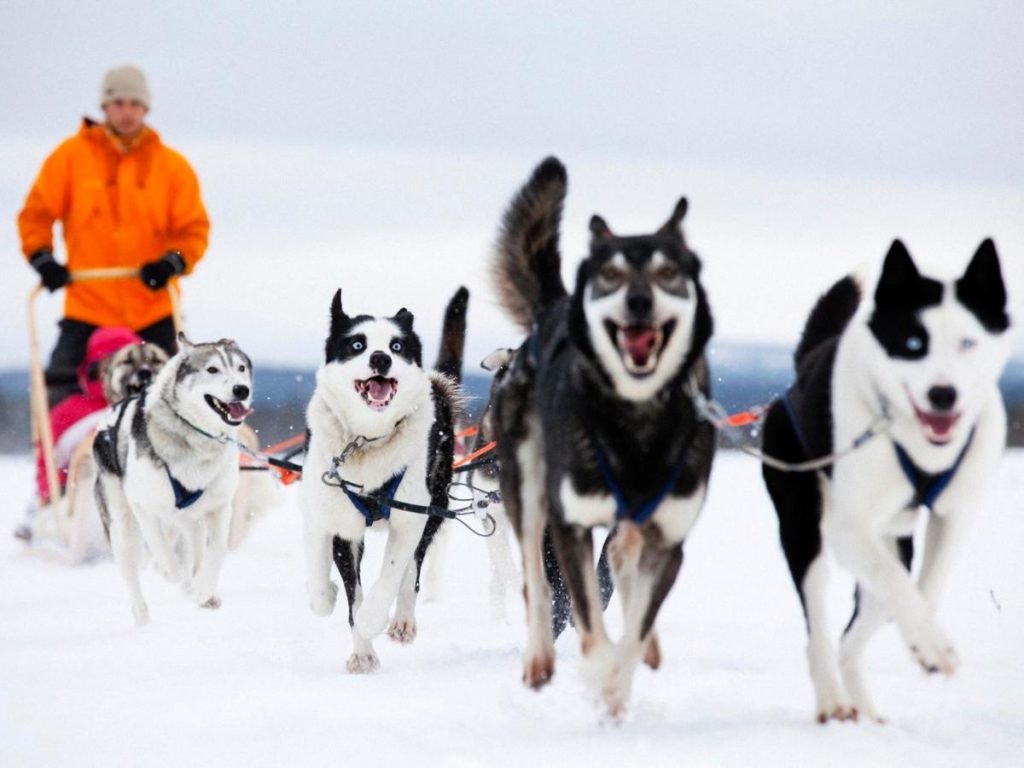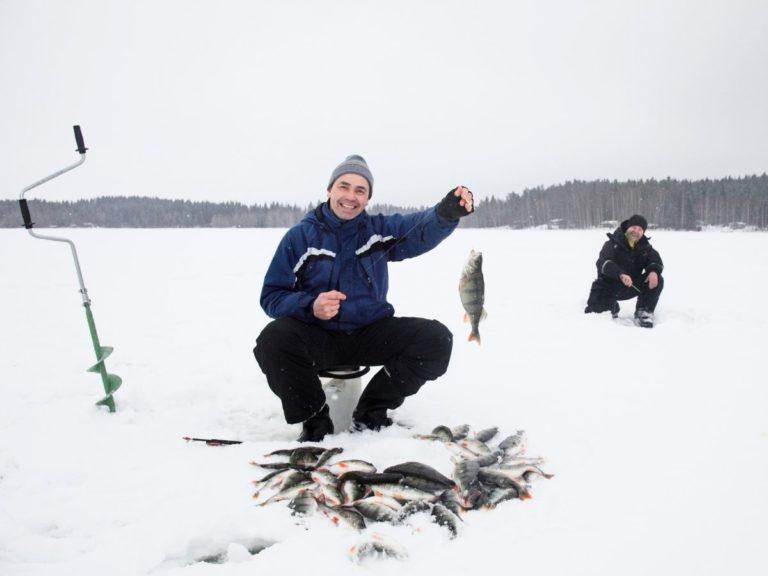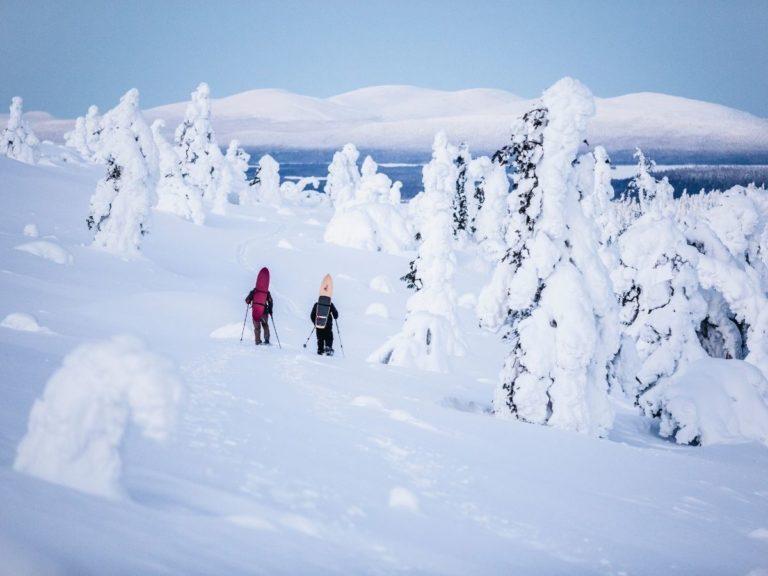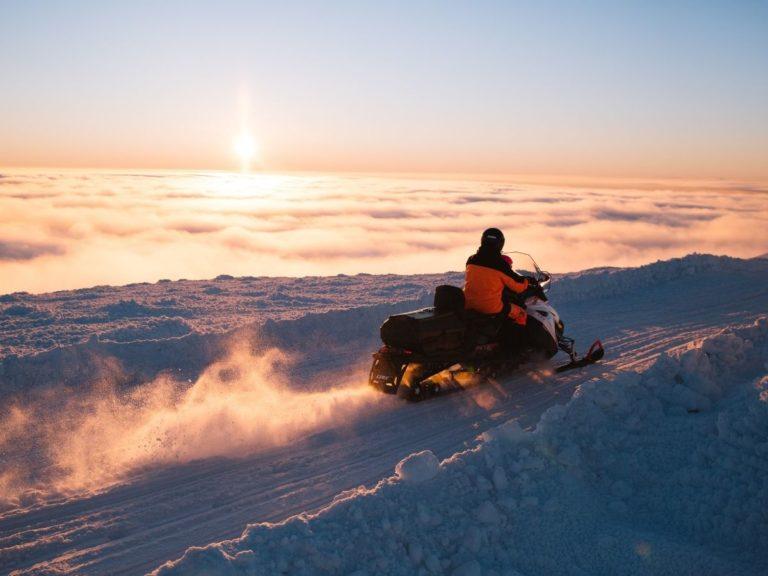Overview of Siberian Husky
The Siberian Husky is a very purebred dog that specializes especially in sled dogs. In terms of tourism in Lapland, this breed is known above all as the leader of husky teams. In terms of size, the breed can be thought of as a medium-sized, fast and light-moving working dog that is very capable of carrying light loads over long distances.
Origin
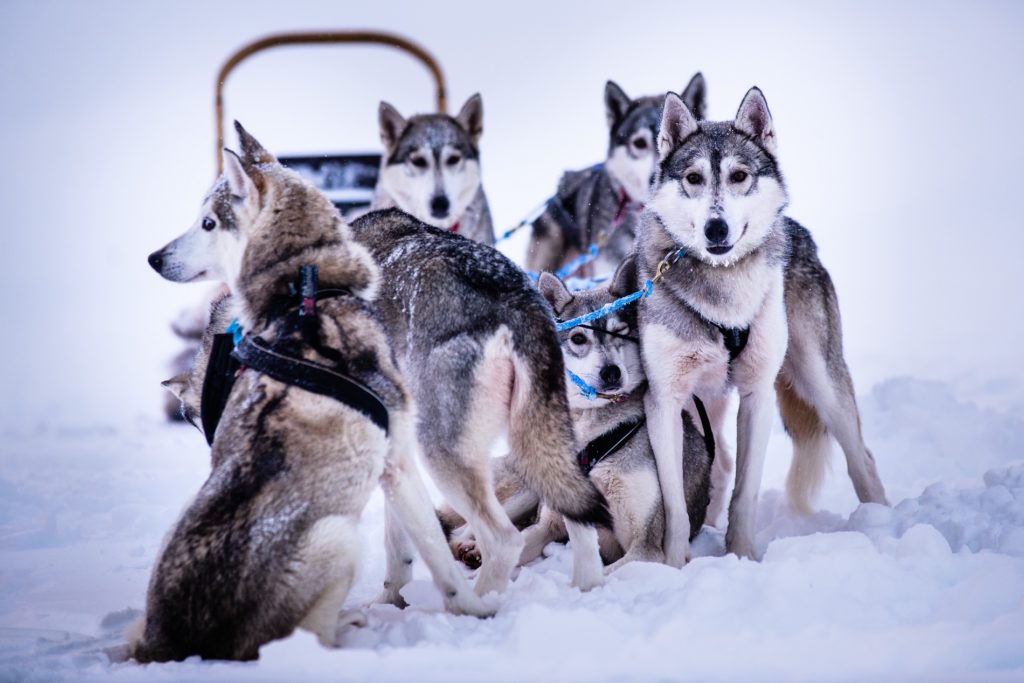
The origins of the Siberian Husky have been traced all the way back to the Chukchi, an ancient tribe from northern Siberia. Despite the extremely unfavorable conditions, the Chukchi bred Siberian husky to endure and even thrive in their cold settlements.
The dogs were originally bred, especially for durability, and quickly became both pets and reliable companions for people living in the harsh conditions of northern Russia. From Russia, this dog breed ended up in Nome, Alaska, thanks to a Russian merchant named William Goosak.
Nome, like many other parts of North America, was in the Gold rush in 1909, and sled dogs were important to people of that time who hoped to get to and from the land of gold with full sacks of gold. The help of sled dogs was needed at that time to transport both supplies and heavy gold catches.
One of the most common myths about the origin of huskies is that they are perceived as a cross between wolves and dogs because of their appearance that refers to wolves. However, huskies are no more related to wolves than other dogs, although they do come from wolves living in the wild.
However, one concrete link between Siberian huskies and wolves has existed to this day. In the film industry, this breed of dog has often been used as a substitute for wolves. This, in all its simplicity, is that domesticated dogs are much easier to train and guide than wolves that live in fences, which are partly like wildlife. The use of huskies in the film industry also does not require so many special permits, which also makes the use of dogs simpler compared to wolves.
Behavior and nature
The Siberian Husky is friendly and gentle in nature, but at the same time alert and sociable. It does not have the typical desire for ownership of watch dogs and is therefore not suspicious of strangers and is not prone to fighting with other dog breeds, for example.
An adult husky can be somewhat reserved and self-respecting by nature. The breed’s intelligence, handling and enthusiasm make it a pleasant companion and a working dog. One of the most important characteristics of a husky is its activity and emergence, which on a practical level means that this dog breed needs a lot of exercise and activation.
What is also noteworthy about the Siberian Husky is that it is a very social and herd-friendly breed that needs at least one companion alongside a happy life. This is one of the main reasons why this dog breed is not well suited for apartment buildings, for example, but its location is much preferred as a working dog alongside other breed companions.
Description

The body of the Siberian Husky is dense in shape and slightly taller in size. The ideal appearance for the breed could be considered to be a well-proportioned general impression, the dog should not be too heavy or lightweight. The height at the withers of the Siberian Husky is usually between 51 and 60 centimeters and the males are slightly larger than the females.
The head of the husky is proportionate in shape, the main law rounded and the skull tapering towards the eyes. The muzzle also tapers towards the tip. The Siberian Husky is characterized by the vertical ears familiar to the vertical ear breeds, which are attached high at the end of the dog. Like many other vertical ears, the breed also has a bushy tail that hangs at rest but curves like a sickle on its back when the dog is attentive or busy with work.
In the nose of the Siberian Husky, it is noteworthy that some members of the breed have a multicolored nose. Often the nose is pink or liver-colored and black. This is called “snow nose” in English, and is a fairly common feature. What is also special about this feature is that a multi-colored nose appears when frosts arrive and, on the other hand, the colors may level off as the temperature rises again.
Siberian husky eyes resemble almonds in shape and are usually slightly oblique. Eyes can be blue, brown or mixed colors. In the case of huskies, it is quite common for a dog to have two eyes of different colors.
The husky’s coat is medium in length, the coat is straight and close to the body, so that the outline of the dog stands out well. The undercoat is very dense and soft, which in turn prohibits adaptation to harsh weather conditions. The erect ears typical of the species, as well as the bushy tail, give it the hallmark of a race from the north.
Husky has two hair loss periods a year, in which case a lot of hair comes off the dogs.
Husky sledding safari is a fast-paced way to get to know to the surrounding nature
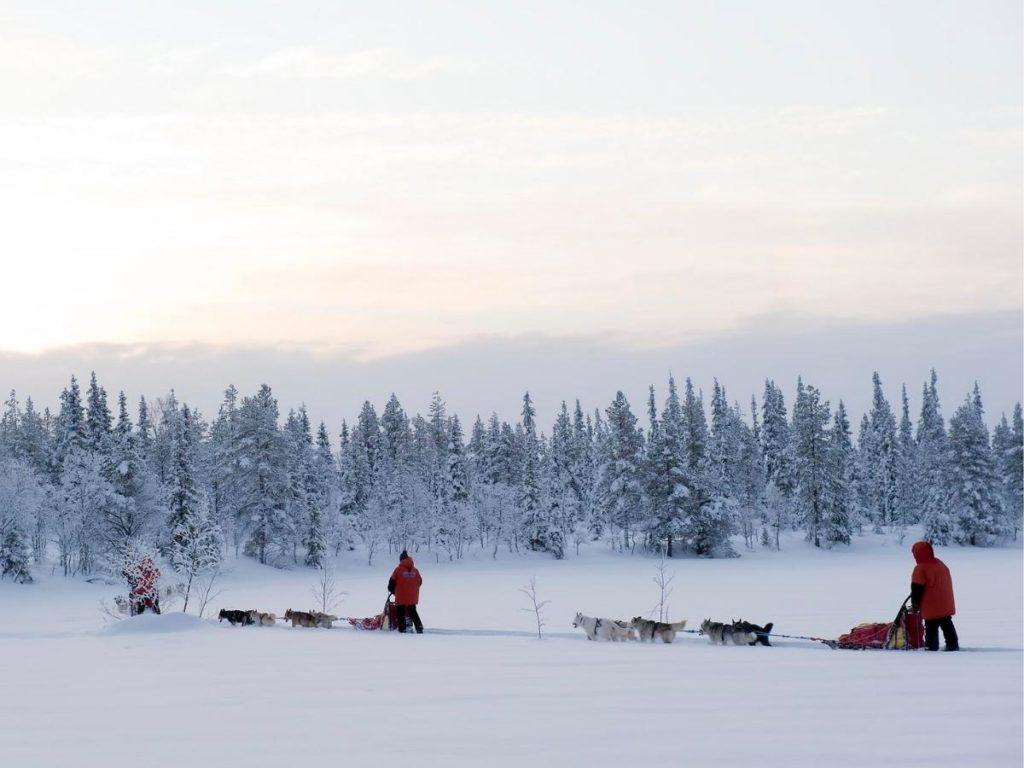
he Siberian Husky was bred into its current form in the United States in the 1930s and the breed has since spread around the world.
Huskies are mainly known today as sled dogs, which also play an important role in the tourism industry. The first Siberian Husky in Finland was registered in 1965 and today the annual registration numbers are about 600 dogs a year. In total, there are an estimated 15,000 Siberian huskies in Finland.
Husky sleigh rides in many Lapland destinations have become very popular, especially by international tourists. It is a fast-paced, traditional and atmospheric way to get to know the beautiful nature of Lapland. Usually, sleigh rides are organized mainly during the winter season, but in many places it is possible to enjoy a fast-paced ride on your favorite activity all year round.
The sleds are typically assembled so that two dogs are placed side by side and there are three or four dogs in a row, which means that there are a total of 6 to 8 dogs pulling the sled.
There are usually two people on board in a sled: one of these acts as the driver of the sled and the other is involved in the role of passenger. Husky safaris are usually so long in terms of duration that it is possible for passengers to change places in the middle of the activity.
General guidelines for husky sledding safari
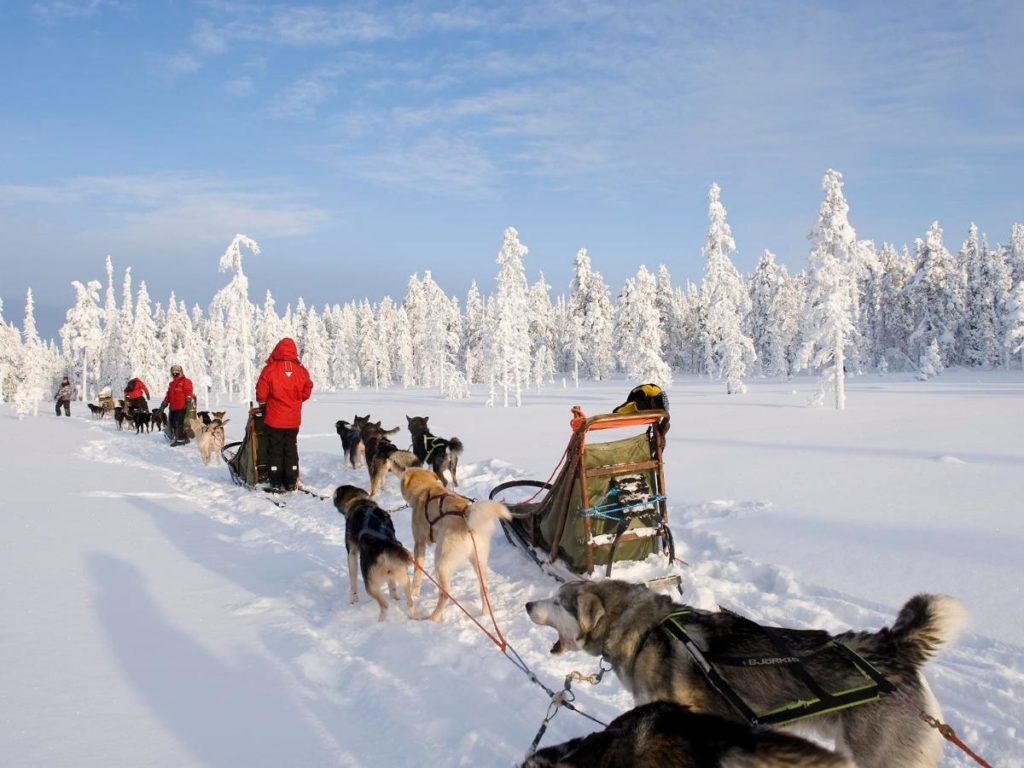
The idea of guiding a sled on a safari may seem challenging and even a little intimidating in advance, but on a practical level it is a fairly approachable activity.
It is the job of the person in the driver’s seat to keep the feet firmly on the sledge’s feet and both hands attached to the guide arch found on the sledge. For safety reasons, the person in the driver must not take pictures while driving, but all concentration must be directed to the safe steering of the team.
Safari also comes with a guide that usually has three pre-displayed hand gestures to help you communicate during the activity.
1) A hand raised straight means a sign of stopping. The sled is stopped by standing on top of the metal brake found on the sled. This also serves as a signal to dogs that stopping is happening.
2) Moving your hand up and down with your elbow bent means moving. At this mark, the sleeve should be pushed slightly forward and at the same time loosen the brake by stepping off the metal part.
3) Moving your hand straight from the top to the side of your body means you need to pay attention, so you need to slow down. In this case, the sled should be slowed down by applying the brake to one foot only, so the other foot will remain on the sled in this situation, allowing the sled to advance, but still decelerating to a level that will react to any obstacle or danger ahead.
When driving with a sled, it is also extremely important to keep a sufficient safety distance to the sled in front. The safety distance means that the distance between the first sled of the sledge, ie the leading dog, and the sledge in front of the sledge is about 5 to 10 meters throughout the safari.
Changing a driver usually takes place in the middle of the Safari and this is done safely so that the person who was previously in the driver’s seat is standing on both feet on the brake throughout the shift. The passenger, in turn, gets up from the sledge and changes from flight to stand on the brake to replace the previous driver. When the new driver is completely on top of the brake, the person who was driving earlier can move to the sledge. The new driver must stand on the brake until the guide involved in the activity gives a new start signal again.
It is also important for a husky safari to dress warmly, as it is possible to organize this activity even in very harsh conditions. Frost also bites much harder when in fast motion. You can find good guidelines for clothes in the winter clothing and layering guide that I published earlier this autumn.
Team work and the lead dog
When working in a team, dogs are required to have excellent teamwork skills, and this generally means that dogs usually get along really well with each other. Despite the importance of teamwork, the herd also requires a good leader, whose main skills include the ability to walk the rope tight and make the other dogs in the team work optimally.
Such traits are usually innate to the huskies and passed down from one generation to the next. The bigger the team, the more the importance of the leading dog is emphasized.
How long distances do the huskies run?
Sleigh rides are available in really different lengths and the longest journeys can be tens or even hundreds of kilometers.
Those who have been well trained are a bit like marathoners, who, when well prepared, can pull a sledge up to 1,700 kilometers a day in dog sled races in demanding conditions in Alaska.
In this case, however, it is worth noting that in these cases we are talking about dogs that have received the right kind of training, for which the focus on the right kind of nutrition and drinking is really important. For example, on husky safaris in Finland, trips are considerably shorter and dogs are also required to do much less physical restraint.
How much exercise do the huskies need?
As I said earlier, the Siberian Husky is a dog breed that has become known for its activity. If the dogs could decide for themselves, they would be happy to run all day long. This feature imposes its own requirements on the dog owner.
For huskies, it is a good idea to start the day with a long run right from the morning and throughout the day you should aim for at least 80 minutes of exercise, the majority of which should be done in the form of running.
In addition to its physical training needs, this dog breed also needs other types of activation, especially for its own. It is a good idea to activate your dog as much as possible during the day to avoid the howling of some husky owners at night, which is usually due to a lack of activity.
Sources and about the subject elsewhere: Wagwalking | 8 awesome Siberian husky facts Visit Finland | A Canine Case – A Ride With the Huskies in Lapland
Main image of the article: Mikko Ryhänen | Visit Finland

